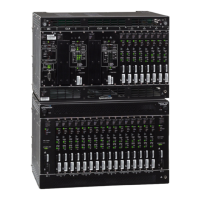Commands
Command Format
26 TimeHub 5500 TL1 Reference Guide 097-55501-02 Issue 7 – January, 2005
Command Format
A command consists of a command code of up to three fields separated by
hyphens, followed by parameter blocks separated by colons. Figure 2-1 shows the
command format. Parameter blocks consist of one or more parameters separated
by commas.
Parameter blocks can be null (contain no parameters), or contain one or more
parameters. Two colons occur next to each other if a parameter block is null.
Multiple parameters in a parameter block are separated by commas. Two commas
occur next to each other if a parameter is null.
Empty blocks at the end of a command line can be omitted.
Entering a semicolon at the end of the command indicates to the interpreter that the
command statement is complete and the command is executed.
Figure 2-1 Command Format and Description
Command Structure
The following examples provide an illustration of command structure and syntax.
Format Example:
RTRV-SYNC[-TSG]:[<tid>]:<aid>:<ctag>:::PARAMETER=<keyword>;
Command Example:
RTRV-SYNC::S2-OUTA-3:SC1:::PARAMETER=SQUELCH;
Null Parameter
Block
Parameter Block
(parameters separated
by comma)
Target
Identifier
(optional
parameter)
Command
Code
Terminating
Semicolon
Fields
command-code:[<tid>]:[<aid>]:<ctag>::[<date>,<time>]:[<keyword>];
Access
Identifier
(optional
parameter)
Correlation
Tag
Spec
Block
(optional
parameter)
Keyword
Block
(optional
parameter)

